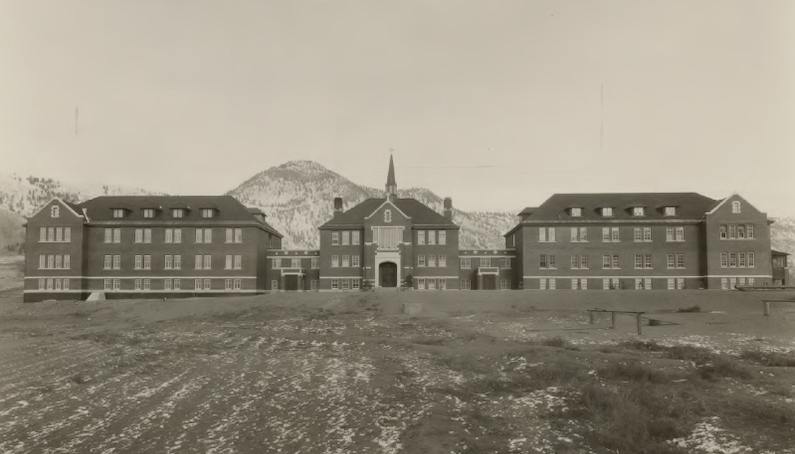The appalling discovery of the bodies of 215 Indigenous children hidden in unmarked graves at the site of the residential school in Kamloops, B.C., is irrefutable evidence of a crime against humanity.
The Tk’emlúps te Secwépemc Band confirmed Thursday that ground-penetrating radar had detected the remains of the children on the grounds of the former Kamloops Indian Residential School, which was operated by the Roman Catholic Church.
Many of us settler Canadians have had to be dragged kicking and screaming to the realization that for generations the policy of the government of Canada toward our country’s first citizens was culturally genocidal in intent and sometimes literally genocidal in practice.
But we are here now and whether we like it or not we are going to be asked to face our national reality and do something about it. We can’t continue to deny that which is no longer deniable.
We need waste no more time on schoolboy arguments about the definition of genocide or nice legal distinctions about what constitutes murder in the Criminal Code.
Upright, honourable people don’t hide evidence of one death in an unmarked, never mentioned grave, let alone 215 of them. This is axiomatic. The prima facie evidence of the crime is in the ground in Kamloops. How hard is it to believe now that more secret graves will soon be found elsewhere?
As for the details and intent of the crime, if it marches like genocide, and talks like genocide, it is genocide.
The intent of the Dominion Government for the Residential School system is part of the historical record. “When the school is on the reserve, the child lives with his parents who are savages … he is simply a savage who can read and write,” John A. Macdonald, our first prime minister, told the House of Commons in 1883 when he introduced the residential school program.
This can’t be spun to mean something else, even if for generations the reality was not often acknowledged in polite society, which by definition was settler society, or taught in schools.
Several major Christian denominations, the police, and the armed forces have all been active co-conspirators.
“We instil in them a pronounced distaste for the native life so that they will be humiliated when reminded of their origin,” said Bishop Vital-Justin Grandin, after whom a high school in Calgary, an LRT station in Edmonton, and a street and neighbourhood in St. Albert are all named.
Educators were tacit enablers. To be schooled in Canada for most of the past century meant never hearing a word about the residential school system. It wasn’t a little secret, but it was an ugly one.
Settler residents of communities where residential schools existed may not have known the details, but they knew something unsavoury was going on in the sinister buildings on the edges of their towns. There was a reason they spoke of these places in hushed tones, and hurried past.
We need to acknowledge all of this.
Now is the time.
Sophomoric tweets and an official silence in Alberta
It is particularly troubling at this tragic and revelatory moment in our national history that a social media stream used by one of the so-called “experts” hired by the Alberta government to draft its deeply flawed primary school social studies curriculum immediately began publishing offensive tweets disparaging the evidence of the Kamloops tragedy as meaningless.
The Twitter account is nominally that of the Dorchester Review, the vanity publication established by Alberta Premier Jason Kenney’s favourite PhD and curriculum adviser, Christian Champion. Whether or not Champion wrote these sophomorically offensive tweets himself has not been confirmed. That would certainly be a worthwhile question for media to ask the reclusive historian.
There is no question the Dorchester Review account’s dismissal Friday of the work of the Truth and Reconciliation Commission as “cash and payola,” and its effort to shrug off the deaths as the result of “tuberculosis or some other disease,” reflects views published by Champion in the past.
It is troubling too, that Kenney employs and looks up to people like Champion and the premier’s former speech writer, Paul Bunner, who wrote “the bogus genocide story of the Canadian Aboriginal residential schools system is an insult to all of us. … “
So is the fact, pointed out by my friend Mimi Williams yesterday on social media, that Kenney himself was moved to a public fit of near apoplexy at the thought a crowd four provinces away had pulled down a statue of prime minister Macdonald, the architect of the residential schools policy, but “the discovery of the remains of over 200 children in the next province generated absolute silence.”
When the statue lost its head in Montreal in August 2020, Kenney offered the fallen effigy a safe home in Alberta. Yesterday evening, hours after Williams’ remark, he published a glib tweet.
So it’s time for some meaningful official acknowledgement of what all this means in Alberta too. A good place to start would be to put that curriculum on the shelf until the job of consultation with Alberta’s First Nations is done properly. If nothing is forthcoming from our government, the inference is obvious.
David Climenhaga, author of the Alberta Diary blog, is a journalist, author, journalism teacher, poet and trade union communicator who has worked in senior writing and editing positions at The Globe and Mail and the Calgary Herald.
Image credit: Archives of the Oblate Order, Richelieu/Wikimedia Commons




